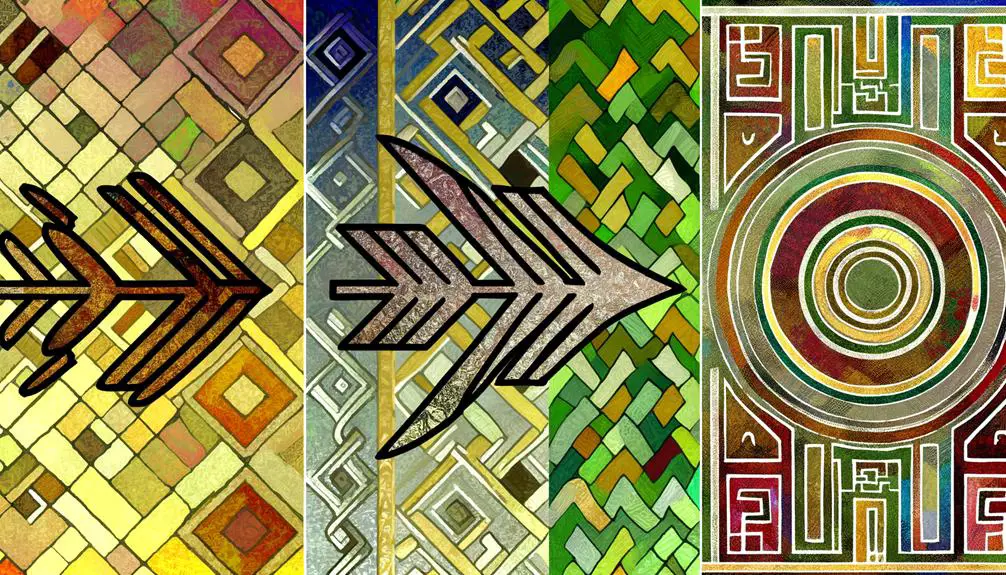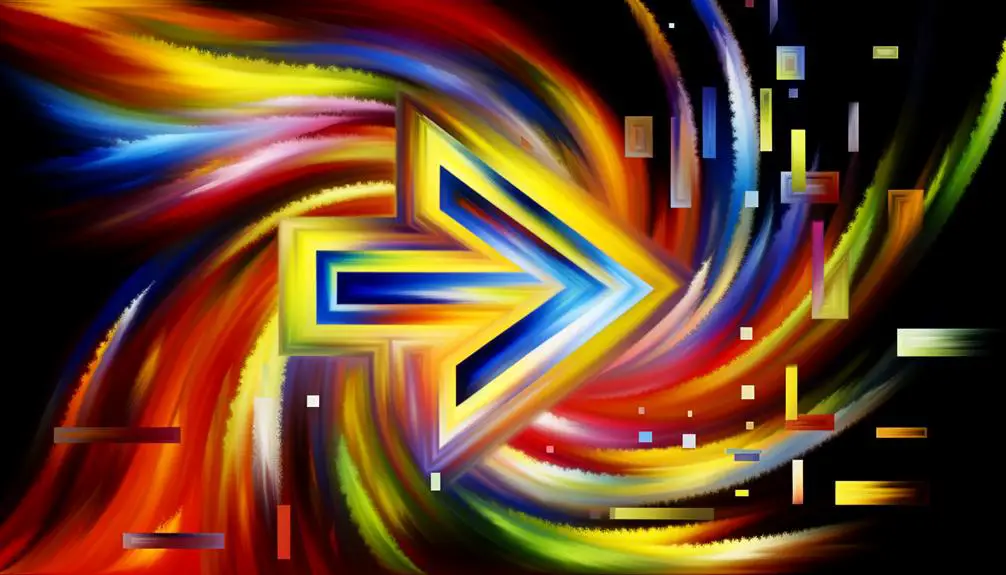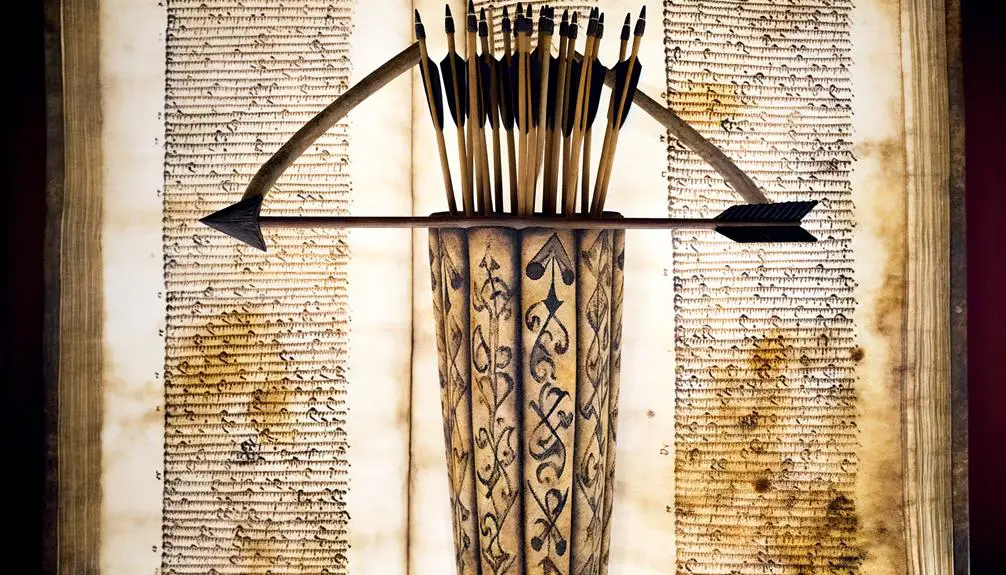Meaning of Arrow Symbols Across Cultures
The arrow symbol, with roots in prehistoric art and ancient cartography, holds profound historical and cultural significance. In ancient Mesopotamian and Egyptian contexts, arrows facilitated military strategies and directional guidance.
Mythologically, they represent power, divine authority, and spiritual ascent, as expressed through figures like Apollo, Arjuna, and Odin. Arrows also symbolize protection, focus, and intent across various cultures.
In modern digital interfaces, arrows denote navigation, direction, and progression. Their linearity and pointed end emphasize purpose and intent, embodying both physical might and emotional depth.
A deeper exploration reveals their multifaceted role in narrative symbolism and thematic expression.

Key Takeaways
- Arrows symbolize direction, guidance, and progression in both historical and modern contexts.
- In mythology, arrows represent power, strength, and divine authority of gods and warriors.
- Arrows signify protection, defense, spiritual ascent, and intent in various cultural traditions.
- Arrows are used in narratives to guide plot progression and highlight character development.
- Historically, arrows have been used in cartography and military strategies for navigation and communication.
Historical Significance

The arrow symbol, with its origins tracing back to prehistoric cave paintings and ancient civilizations, has historically served as an important tool for communication and navigation.
In early human societies, simplified depictions of arrows were utilized in petroglyphs and hieroglyphics to convey directions and indicate movement. Archaeological findings reveal that ancient Mesopotamians and Egyptians employed arrow symbols in their cartographic representations and military strategies.
Technically, the arrow's linearity and pointed end provided an intuitive method for guiding observers towards a specific path or target. This iconography, embedded within early artifacts, facilitated the development of more complex navigational aids, including maps and compasses.
The arrow's enduring presence underscores its fundamental role in the evolution of human spatial awareness and communication methodologies.
Cultural Interpretations

How has the arrow symbol, through diverse cultural lenses, come to embody a myriad of meanings and connotations that extend beyond its original utilitarian purpose?
Historically, arrows were primarily tools of hunting and warfare, but cultural interpretations have vastly expanded their symbolic significance.
In Native American cultures, arrows often signify protection and defense. The directionality of arrows is pivotal, with upward arrows representing spiritual ascent and downward arrows symbolizing peace.
In modern contexts, arrows are ubiquitous in digital interfaces, denoting direction, progression, or change.
Additionally, in Eastern philosophies, arrows can symbolize focus and intent. Each cultural framework assigns nuanced meanings to the arrow, reflecting its intrinsic versatility and adaptability to various symbolic needs.
Arrow in Mythology

In mythology, the arrow often embodies symbolic power and strength, as seen in the narratives of gods and heroes wielding it as a formidable weapon. Examples include Apollo in Greek mythology or the Hindu god Arjuna.
Additionally, the arrow serves as a potent emblem of guidance and direction, signifying the path towards destiny or enlightenment. This symbolism is exemplified by the North American indigenous myth of the Sacred Arrow.
These dual aspects underscore the arrow's multifaceted role in mythological contexts, where it is both a tool of might and a beacon of navigation.
Symbolic Power and Strength
Throughout various mythologies, arrows have often been depicted as potent symbols of power and strength, embodying both the physical might of warriors and the divine authority of gods.
In Greek mythology, the arrows of Artemis and Apollo signify their unparalleled prowess in hunting and warfare. Similarly, in Hindu epics, Arjuna's divine arrows, bestowed by the gods, exemplify his heroic valor.
The Norse god Odin's spear, Gungnir, though not an arrow, shares the same symbolic resonance of unerring strength. These mythological narratives utilize the arrow as a vector of decisive force and destiny, encapsulating its duality as a weapon of mortal combat and an instrument of divine will.
Such representations underscore the arrow's enduring legacy as an emblem of formidable power.
Guidance and Direction
The arrow, beyond its role as a weapon, has historically served as a powerful symbol of guidance and direction in various mythological contexts. It often illustrates the path one must follow toward destiny or enlightenment.
In Greek mythology, the arrows of Eros, the god of love, signify the transformative journey of the heart. Similarly, in Hindu traditions, the arrows of Kama, the god of desire, guide individuals toward spiritual and emotional fulfillment.
Norse mythology features the arrow of Skadi, a symbol of precise focus and destined paths. These mythological narratives employ the arrow as an emblem of purpose, illustrating how it directs individuals toward significant life events or spiritual awakening, encapsulating the essence of guided progression.
Arrows in Art

Leveraging their rich symbolic heritage, arrows in art have served as versatile motifs that convey a myriad of meanings across diverse cultures and historical periods. From ancient cave paintings to Renaissance masterpieces, arrows have encapsulated themes such as love, war, and destiny.
In classical mythology, Cupid's arrows symbolize romantic desire, while in Christian iconography, arrows often represent martyrdom and divine intervention. Technically, the design of arrows in art can vary from simple linear forms to intricate, stylized representations, reflecting the artist's intention and the cultural context.
The directionality of arrows—whether pointing upwards, downwards, or sideways—adds layers of meaning, suggesting notions of transcendence, decline, or movement. Arrows remain potent visual elements that enrich artistic narratives.
Digital Design Usage

In digital design, arrows function as pivotal navigational tools, guiding users through interfaces and enhancing user experience by providing clear directional cues.
Historically, the adoption of arrows in digital environments can be traced back to early graphical user interfaces (GUIs) in the 1980s, where they were employed to indicate actions such as scrolling and pagination.
Technically, arrows are integral in user interface (UI) design for their ability to intuitively convey movement and direction. They are employed in buttons, sliders, and dropdown menus, often facilitating seamless interaction.
Arrows in Navigation

Arrows have long served as essential visual aids in guidance systems, providing clear and intuitive direction across various contexts, from physical wayfinding in urban environments to virtual pathfinding in complex digital interfaces.
Historically, arrows have been employed in cartography since the early days of map-making, offering directional cues that simplify spatial orientation.
In modern urban planning, arrows on road signs and pedestrian paths facilitate efficient movement, minimizing congestion and enhancing safety.
In digital domains, arrows are pivotal in user interface (UI) design, aiding users in exploring websites and applications by indicating actions such as scrolling, clicking, and moving between screens.
The consistent use of arrow symbols in guidance harnesses their inherent directional clarity, ensuring ease of understanding and functionality.
Psychological Impacts

The presence of arrow symbols can have significant psychological effects, as their simplicity and universality often evoke immediate cognitive responses that facilitate decision-making and spatial orientation.
Historically, arrows have been utilized in various cultures to convey direction and intent, leveraging their linear structure to guide human perception. From a neuropsychological perspective, arrows engage the brain's parietal lobe, responsible for spatial awareness and navigation.
This immediate recognition is vital in high-stress environments, such as emergency exits, where rapid understanding can be life-saving. Additionally, the arrow's directness minimizes cognitive load, enhancing focus and reducing decision fatigue.
In urban settings, their ubiquitous presence on signs and pathways underscores their role in promoting efficient human movement and reducing environmental confusion.
Symbolism in Literature

In literary contexts, arrows often serve as potent symbols, deeply rooted in mythology and serving as narrative direction indicators. Historically, arrows have been emblematic of fate, destiny, and the divine intervention of gods, as seen in mythological tales like those of Cupid or Apollo.
Moreover, in narrative structures, arrows frequently guide readers through thematic progression and character development, symbolizing pivotal turning points or directional shifts within a story's arc.
Arrows in Mythology
Throughout ancient mythological texts, arrow symbols have been utilized to convey complex narratives and cultural beliefs. In Greek mythology, arrows wielded by figures such as Eros and Artemis symbolize love and divine retribution. Eros' arrows, for instance, could ignite passionate love or indifference, reflecting the duality of human emotions.
Similarly, in Hindu mythology, the god Kama uses arrows to incite desire, reinforcing their role as instruments of fate and divine will. The Norse mythological figure, Skadi, uses arrows to epitomize vengeance and justice. These examples illustrate that arrows transcend mere weaponry, embodying potent symbols of destiny, emotional states, and moral principles, intricately woven into the cultural and spiritual fabric of ancient civilizations.
Narrative Direction Indicators
As a powerful literary device, arrow symbols in literature often serve to guide readers through the narrative, indicating shifts in direction, focus, or thematic development. Historically, authors have employed arrow imagery to:
- Highlight character metamorphosis: Arrows can signify a pivotal change in a character's journey or mindset.
- Indicate plot progression: These symbols often mark pivotal turning points or shifts within the storyline.
- Enhance thematic depth: Arrows may represent abstract concepts such as fate, destiny, or the passage of time.
- Direct reader attention: They can subtly lead the reader to key elements or foreshadow future events.
Understanding the nuanced application of arrow symbols aids in comprehending the deeper layers of narrative structure and thematic resonance, thereby enriching the reading experience.
Conclusion
The arrow symbol, deeply embedded in historical, cultural, and digital contexts, serves multifaceted roles from navigation to psychological influence.
Despite potential objections regarding its simplicity, the arrow's enduring relevance and adaptability underscore its complexity and significance.
Recognizing its varied interpretations in mythology, art, and literature enhances comprehension of its pervasive presence in human communication and design.
The arrow's capacity to convey direction, movement, and intent guarantees its continued utility and symbolic power across disciplines.






